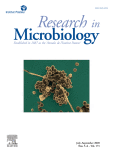Ver ítem
- xmlui.general.dspace_homeCentros e Institutos de InvestigaciónCICVyA. Centro de Investigación en Ciencias Veterinarias y AgronómicasInstituto de BiotecnologíaArtículos científicosxmlui.ArtifactBrowser.ItemViewer.trail
- Inicio
- Centros e Institutos de Investigación
- CICVyA. Centro de Investigación en Ciencias Veterinarias y Agronómicas
- Instituto de Biotecnología
- Artículos científicos
- Ver ítem
Multiple ways to evade the bacteriostatic action of glyphosate in rhizobia include the mutation of the conserved serine 90 of the nitrogenase subunit NifH to alanine
Resumen
The genome resequencing of spontaneous glyphosate-resistant mutants derived from the soybean inoculant E109 allowed identifying genes most likely associated with the uptake (gltL and cya) and metabolism (zigA and betA) of glyphosate, as well as with nitrogen fixation (nifH). Mutations in these genes reduce the lag phase and improve nodulation under glyphosate stress. In addition to providing glyphosate resistance, the amino acid exchange Ser90Ala in NifH
[ver mas...]
The genome resequencing of spontaneous glyphosate-resistant mutants derived from the soybean inoculant E109 allowed identifying genes most likely associated with the uptake (gltL and cya) and metabolism (zigA and betA) of glyphosate, as well as with nitrogen fixation (nifH). Mutations in these genes reduce the lag phase and improve nodulation under glyphosate stress. In addition to providing glyphosate resistance, the amino acid exchange Ser90Ala in NifH increased the citrate synthase activity, growth rate and plant growth-promoting efficiency of E109 in the absence of glyphosate stress, suggesting roles for this site during both the free-living and symbiotic growth stages.
[Cerrar]

Autor
Liebrenz, Karen Ivana;
Frare, Romina Alejandra;
Gomez, Maria Cristina;
Pascuan, Cecilia Gabriela;
Brambilla, Silvina Maricel;
Soldini, Diego Omar;
Maguire, Vanina;
Carrio, Alejandro Javier;
Ruiz, Oscar;
McCormick, Wayne;
Soto, Gabriela Cynthia;
Ayub, Nicolás Daniel;
Fuente
Research in Microbiology 173 (6-7) : 103952 (Julio-Septiembre 2022)
Fecha
2022-07
Editorial
Elsevier
ISSN
1769-7123
Documentos Relacionados
Formato
pdf
Tipo de documento
artículo
Proyectos
(ver más)
INTA/2019-PE-E6-I115-001/2019-PE-E6-I115-001/AR./Edición génica, transgénesis y mutagénesis como generadores de nueva variabilidad en especies de interés agropecuario
INTA/2019-PD-E6-I116-001/2019-PD-E6-I116-001/AR./Identificación y análisis funcional de genes o redes génicas de interés biotecnológico con fin agropecuario, forestal, agroalimentario y/o agroindustrial.
Palabras Claves
Derechos de acceso
Embargado
 Excepto donde se diga explicitamente, este item se publica bajo la siguiente descripción: Creative Commons Attribution-NonCommercial-ShareAlike 2.5 Unported (CC BY-NC-SA 2.5)
Excepto donde se diga explicitamente, este item se publica bajo la siguiente descripción: Creative Commons Attribution-NonCommercial-ShareAlike 2.5 Unported (CC BY-NC-SA 2.5)

